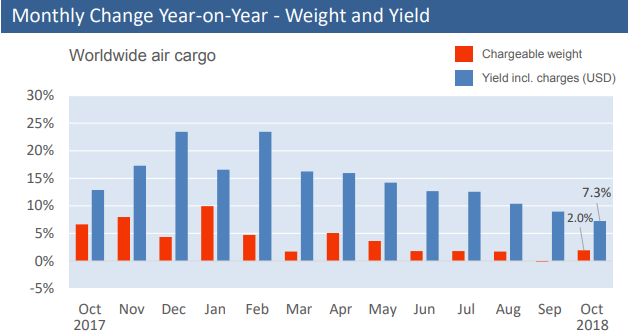No products in the cart.
WorldACD October report shows modest growth, minimal effect from trade wars
 The latest data from WorldACD provides grounds for optimism for those concerned with international demand for air cargo, following September’s discouraging results, when volumes sunk for the first time in years, by 0.9 percent. October’s report, released yesterday, shows a modest 2 percent increase in international volume and a 7 percent increase in air cargo yield to US$1.99, year-over-year.
The latest data from WorldACD provides grounds for optimism for those concerned with international demand for air cargo, following September’s discouraging results, when volumes sunk for the first time in years, by 0.9 percent. October’s report, released yesterday, shows a modest 2 percent increase in international volume and a 7 percent increase in air cargo yield to US$1.99, year-over-year.
Despite the industry’s anticipation of potential contractions caused by Trump-era protectionist trade policies, Asia-Pacific was the top performing region, with incoming and outgoing traffic growth figures of 4.2 and 2.7 percent, respectively, during the month.
In fact, looking specifically at westbound traffic from China to the United States, the trade lane grew faster than any other of China’s major recipients of air cargo. The data shows a 4.5 percent, y-o-y, increase, largely fueled by a rise in the transport of vulnerable and high-tech goods. This specific industry sector saw a 30.5 percent increase, which WorldACD said is “much more than the usual seasonal upswing” – likely a symptom of American firms stockpiling inventories in anticipation of the effects of tariffs.
Another notable trend in the Asia-Pacific region was the yields spike, measured in dollars, between Hong Kong and the U.S., which increased 19.5 percent to $4.47, y-o-y.
Looking at other international regions, traffic growth was a bit less robust. European imports and exports grew by 0.5 and 2.7 percent, respectively, and 3.4 and 0.1 percent in the Middle East and South Asia (MESA) region.
Africa and North America both increased import volumes, but decreased export volumes, while Central and South America did the opposite, boosting its exports to Asia-Pacific by 33 percent, due to an increase in demand in Asia for Latin American perishable exports, such as seafood.
















